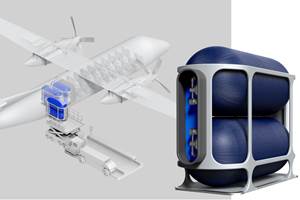Automated composites manufacturing, past, present and future
CW guest columnist Rob Sjostedt is a partner and CEO at VectorSum Inc. He recalls his days at Goldsworthy Engineering and reminds CW readers that today’s product requirements are more challenging than ever, and creative new approaches are required.
The 1970s and 1980s were dynamic periods in the development of automated composites manufacturing. In that time, Brandt Goldsworthy of Goldsworthy Engineering (Torrance, CA, US) and his team pioneered the first commercial pultrusion machines, and developed tape laying and fiber placement machines, numerous innovative custom machines and many variations of filament winding. I was fortunate to spend my early career working for and being mentored by Goldsworthy before becoming his company manager. It is interesting to look back and consider what has become of those pioneering efforts. Which pioneering processes have survived and become common today? Which processes still have unrealized potential? What are the future advancements in automated processing going to be?
Pultrusion has been one of the fastest growing commercial processes for some time. Pultruded products have clearly established their niche. Today’s machines have changed very little in concept from Goldsworthy’s original Glastruder. In-die injection is probably the most significant advancement since the process was commercialized. The addition of multiaxial fabrics has enabled pultrusion of more sophisticated laminates. Further development of lightweight and high-strength, yet cost-effective, profiles is the future challenge if pultrusion is to compete head-to-head with traditional materials. Joining pultruded profiles into large, integrated structures is another challenge that must be tackled.
Looking back, it is surprising that Pulforming, a Goldsworthy variation of the pultrusion process, has not been further developed or more broadly applied. Pulforming, which combines step compression molding with pultrusion material infeed technology, can enable continuous, automated manufacture of curved parts and parts with nonuniform cross sections. Maybe this recollection will inspire others to revisit the process and take it to the next level.
Goldsworthy made the first tape layer in the early 1970s and the first fiber placement machine in the mid-1980s, but both were hampered by machine-control technology limitations. The emergence of modern computer control/servomotor technology enabled these machines to become common, productive systems in aerospace. It is refreshing to note that probably the largest use of fiber placement is outside of the aerospace market. In the 1990s, North Sails (Milford, CT, US) applied the basic principles of large gantry-based fiber placement to sail manufacturing in a very big way. Literally thousands of fiber-reinforced sails have been made over configurable molds by the company’s unique 3DL process. North’s latest development, the 3Di process, is a true composite-laminate sail made using CAD and CAM. Goldsworthy would have been very pleased to see these developments! Maybe the same principles can be applied to large flexible architectural enclosures.
Southern Spars (Auckland, New Zealand) has applied tape laying to carbon fiber sailboat mast manufacture, and some of its projects are very large. Carbon fiber masts more than 46m tall are commonly made, and a recent project produced a 90m mast for a 90m yacht. These masts are stabilized with carbon fiber rigging made from bundled pultruded carbon rods or continuously wound rigging members. In the case of a 90m mast, the standing rigging elements are up to 90 mm in diameter with tensile strengths of more than 900,000 kg. These are serious engineering challenges, met using automated manufacturing technology.
Another Goldsworthy development with still unrealized potential is the combination of filament winding and pultrusion into one machine. Over-winding wheels upstream from a standard pultrusion machine enables manufacturers to make tubular products with optimized fiber orientations, and to do so on a continuous basis. With today’s materials and computer control systems, these technologies offer the opportunity to make high-performance tubulars for the oil and gas market in a cost-effective manner.
As product designers and manufacturing engineers work to develop future products, it is important to pick the right process or combination of processes. Today’s product requirements are more challenging than ever, and creative new processes and approaches are often required. At my current company, VectorSum Inc. (Irvine, CA, US), we strive to find the optimal solution from the rational combination of all constraints, requirements, expectations, capabilities and experience that constitute the boundary conditions of a problem. By imagining each of these determinants as a vector, the sum of the vectors defines the solution. This approach can lead one to step out of conventional practice and come up with creative system-engineering solutions. Much like Brandt Goldsworthy did in his lifetime of contribution to the composites industry.
Related Content
Advanced Fiberglass Industries: Composites enable innovation
With decades of composites design and fabrication experience, Dubai-based AFI turns problems into solutions.
Read MoreModernizing the mechanical rotor sail
Composites are key for Norsepower’s award-winning redesign of a century-old rotor sail for reducing carbon emissions on passenger and cargo ships.
Read MoreThe lessons behind OceanGate
Carbon fiber composites faced much criticism in the wake of the OceanGate submersible accident. CW’s publisher Jeff Sloan explains that it’s not that simple.
Read MoreCarbon fiber in pressure vessels for hydrogen
The emerging H2 economy drives tank development for aircraft, ships and gas transport.
Read MoreRead Next
CW’s 2024 Top Shops survey offers new approach to benchmarking
Respondents that complete the survey by April 30, 2024, have the chance to be recognized as an honoree.
Read MoreFrom the CW Archives: The tale of the thermoplastic cryotank
In 2006, guest columnist Bob Hartunian related the story of his efforts two decades prior, while at McDonnell Douglas, to develop a thermoplastic composite crytank for hydrogen storage. He learned a lot of lessons.
Read MoreComposites end markets: Energy (2024)
Composites are used widely in oil/gas, wind and other renewable energy applications. Despite market challenges, growth potential and innovation for composites continue.
Read More






















